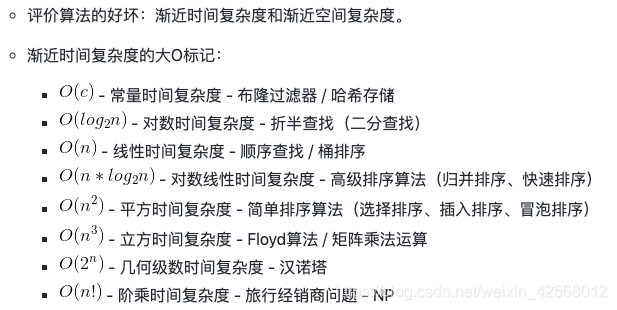常用算法:
- 穷举法 - 又称为暴力破解法,对所有的可能性进行验证,直到找到正确答案。
- 贪婪法 - 在对问题求解时,总是做出在当前看来 最好的选择,不追求最优解,快速找到满意解。
- 分治法 - 把一个复杂的问题分成两个或更多的相同或相似的子问题,再把子问题分成更小的子问题,直到可以直接求解的程度,最后将子问题的解进行合并得到原问题的解。
- 回溯法 - 回溯法又称为试探法,按选优条件向前搜索,当搜索到某一步发现原先选择并不优或达不到目标时,就退回一步重新选择。
- 动态规划 - 基本思想也是将待求解问题分解成若干个子问题,先求解并保存这些子问题的解,避免产生大量的重复运算。


排序算法
def select_sort(origin_items, comp=lambda x, y: x < y):
"""简单选择排序"""
items = origin_items[:]
for i in range(len(items) - 1):
min_index = i
for j in range(i + 1, len(items)):
if comp(items[j], items[min_index]):
min_index = j
items[i], items[min_index] = items[min_index], items[i]
return items
def bubble_sort(origin_items, comp=lambda x, y: x > y):
"""高质量冒泡排序(搅拌排序)"""
items = origin_items[:]
for i in range(len(items) - 1):
swapped = False
for j in range(i, len(items) - 1 - i):
if comp(items[j], items[j + 1]):
items[j], items[j + 1] = items[j + 1], items[j]
swapped = True
if swapped:
swapped = False
for j in range(len(items) - 2 - i, i, -1):
if comp(items[j - 1], items[j]):
items[j], items[j - 1] = items[j - 1], items[j]
swapped = True
if not swapped:
break
return items
def merge_sort(items, comp=lambda x, y: x <= y):
"""归并排序(分治法)"""
if len(items) < 2:
return items[:]
mid = len(items) // 2
left = merge_sort(items[:mid], comp)
right = merge_sort(items[mid:], comp)
return merge(left, right, comp)
def merge(items1, items2, comp):
"""合并(将两个有序的列表合并成一个有序的列表)"""
items = []
index1, index2 = 0, 0
while index1 < len(items1) and index2 < len(items2):
if comp(items1[index1], items2[index2]):
items.append(items1[index1])
index1 += 1
else:
items.append(items2[index2])
index2 += 1
items += items1[index1:]
items += items2[index2:]
return items
def seq_search(items, key):
"""顺序查找"""
for index, item in enumerate(items):
if item == key:
return index
return -1
def bin_search(items, key):
"""折半查找"""
start, end = 0, len(items) - 1
while start <= end:
mid = (start + end) // 2
if key > items[mid]:
start = mid + 1
elif key < items[mid]:
end = mid - 1
else:
return mid
return -1
来源:CSDN
作者:soda東風
链接:https://blog.csdn.net/weixin_42568012/article/details/103779919